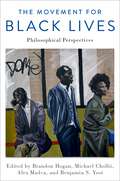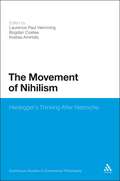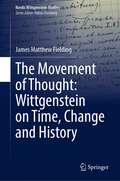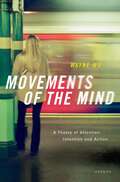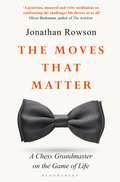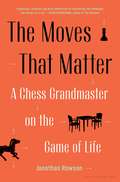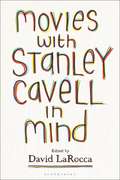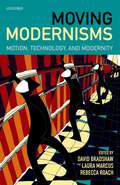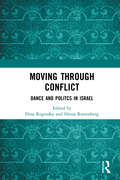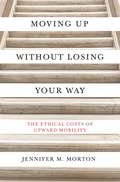- Table View
- List View
Movement as Meaning in Experimental Cinema: The Musical Poetry of Motion Pictures Revisited
by Daniel BarnettMovement as Meaning in Experimental Cinema offers sweeping and cogent arguments as to why analytic philosophers should take experimental cinema seriously as a medium for illuminating mechanisms of meaning in language. Using the analogy of the movie projector, Barnett deconstructs all communication acts into functions of interval, repetition and context. He describes how Wittgenstein's concepts of family resemblance and language games provide a dynamic perspective on the analysis of acts of reference. He then develops a hyper-simplified formula of movement as meaning to discuss, with true equivalence, the process of reference as it occurs in natural language, technical language, poetic language, painting, photography, music, and of course, cinema. Barnett then applies his analytic technique to an original perspective on cine-poetics based on Paul Valery's concept of omnivalence, and to a projection of how this style of analysis, derived from analog cinema, can help us clarify our view of the digital mediasphere and its relation to consciousness. Informed by the philosophy of Quine, Dennett, Merleau-Ponty as well as the later work of Wittgenstein, among others, he uses the film work of Stan Brakhage, Tony Conrad, A.K. Dewdney, Nathaniel Dorsky, Ken Jacobs, Owen Land, Saul Levine, Gregory Markopoulos Michael Snow, and the poetry of Basho, John Cage, John Cayley and Paul Valery to illustrate the power of his unique perspective on meaning.
The Movement for Black Lives: Philosophical Perspectives
by Brandon Hogan, Michael Cholbi, Alex Madva, Benjamin S. YostThe Movement for Black Lives (M4BL) has gained worldwide visibility as a grassroots social justice movement distinguished by a decentralized, non-hierarchal mode of organization, and in 2020 Black Lives Matter protests across the country shook America's moral conscience to its core. M4BL rose to prominence in part thanks to its protests against police brutality and misconduct directed at Black Americans. However, its animating concerns are far broader, calling for a wide range of economic, political, legal, and cultural measures to address what it terms a "war against Black people," as well as the "shared struggle with all oppressed people." Yet despite the significance of the social, political, and economic goals of M4BL, as well as the innovative organizational leadership strategies it employs, M4BL has so far received little sustained philosophical attention. The Movement for Black Lives: Philosophical Perspectives brings philosophical analysis to bear on the aims, strategies, policy positions, and intellectual-historical context of M4BL. Leading scholars tackle such themes as: "Black Lives Matter" as a political speech act, M4BL's conception of the value of Black lives, the gender dynamics of the Movement, the relation of M4BL to other Black liberation movements and transitional justice movements, the Movement's new forms of leadership and organization, and the impact of racism on the normative assessment of the criminal justice system. The volume broaches a wide range of pressing issues in the philosophy of language, social and political philosophy, philosophy of race, philosophy of gender, and the philosophy of punishment. It is vital reading for students and scholars in the humanities and social sciences interested in race, inequality, and social justice movements.
The Movement for Black Lives: Philosophical Perspectives
The Movement for Black Lives (M4BL) has gained worldwide visibility as a grassroots social justice movement distinguished by a decentralized, non-hierarchal mode of organization, and in 2020 Black Lives Matter protests across the country shook America's moral conscience to its core. M4BL rose to prominence in part thanks to its protests against police brutality and misconduct directed at Black Americans. However, its animating concerns are far broader, calling for a wide range of economic, political, legal, and cultural measures to address what it terms a "war against Black people," as well as the "shared struggle with all oppressed people." Yet despite the significance of the social, political, and economic goals of M4BL, as well as the innovative organizational leadership strategies it employs, M4BL has so far received little sustained philosophical attention. The Movement for Black Lives: Philosophical Perspectives brings philosophical analysis to bear on the aims, strategies, policy positions, and intellectual-historical context of M4BL. Leading scholars tackle such themes as: "Black Lives Matter" as a political speech act, M4BL's conception of the value of Black lives, the gender dynamics of the Movement, the relation of M4BL to other Black liberation movements and transitional justice movements, the Movement's new forms of leadership and organization, and the impact of racism on the normative assessment of the criminal justice system. The volume broaches a wide range of pressing issues in the philosophy of language, social and political philosophy, philosophy of race, philosophy of gender, and the philosophy of punishment. It is vital reading for students and scholars in the humanities and social sciences interested in race, inequality, and social justice movements.
The Movement of Nihilism: Heidegger's Thinking After Nietzsche (Continuum Studies in Continental Philosophy)
by Laurence Paul Hemming Kostas Amiridis Bogdan CosteaWhen Nietzsche announced 'the advent of nihilism' in 1887/88, he argued that he was sketching 'the history of the next two centuries': 'For some time now', he wrote, 'our whole European culture has been moving as toward catastrophe [...]: restlessly, violently, headlong, like a river that want to reach the end, that no longer reflects, that is afraid to reflect.'Can we gain a ground for reflection upon our own condition? Can we heed Nietzsche's warning? Can we respond to the challenge? In this book, eleven newly commissioned essays from leading scholars offer an attempt to grasp Nietzsche's prescience through Heidegger's critique of it; attempting to think through the philosophical consequences of the last century in reading the signs of our own condition. The book also provides and fascinating and unique discussion of some of the lesser-known texts of the later Heidegger.
The Movement of Nihilism: Heidegger's Thinking After Nietzsche (Continuum Studies in Continental Philosophy)
by Laurence Paul Hemming Kostas Amiridis Bogdan CosteaWhen Nietzsche announced 'the advent of nihilism' in 1887/88, he argued that he was sketching 'the history of the next two centuries': 'For some time now', he wrote, 'our whole European culture has been moving as toward catastrophe [...]: restlessly, violently, headlong, like a river that want to reach the end, that no longer reflects, that is afraid to reflect.'Can we gain a ground for reflection upon our own condition? Can we heed Nietzsche's warning? Can we respond to the challenge? In this book, eleven newly commissioned essays from leading scholars offer an attempt to grasp Nietzsche's prescience through Heidegger's critique of it; attempting to think through the philosophical consequences of the last century in reading the signs of our own condition. The book also provides and fascinating and unique discussion of some of the lesser-known texts of the later Heidegger.
The Movement of Thought: Wittgenstein on Time, Change and History (Nordic Wittgenstein Studies #9)
by James Matthew FieldingThis book covers the topic of history and the role that it played in the Austrio-British philosopher Ludwig Wittgenstein’s thought. The topic is explored from multiple angles, both chronologically and thematically. Reviewing Wittgenstein’s two magnum opera - the Tractatus Logico-Philosophicus (1921) and Philosophical Investigations (1952), this work is an investigation into an under-acknowledged element in Wittgenstein’s thought, one which in many cases acted as an impetus for that life-long process of novel philosophical reflection: History.This volume traces the evolution of Wittgenstein’s thoughts on time and temporality from the Tractatus, through the Investigations, into some key post-Investigations remarks and also examines the motivations behind Wittgenstein’s post-Tractarian return to philosophy and, in particular, the unique methodology he developed in order to serve his renewed purpose. The final chapter seeks to answer the question, What was Wittgenstein trying to achieve with Philosophical Investigations? This book is of interest to philosophers.
Movements of the Mind: A Theory of Attention, Intention and Action
by Wayne WuMovements of the Mind is about what it is to be an agent. Focusing on mental agency, it integrates multiple approaches, from philosophical analysis of the metaphysics of agency to the activity of neurons in the brain. Philosophical and empirical work are combined to generate concrete explanations of key features of the mind. The book should be relevant and accessible to philosophers and scientists interested in mind and agency. Wu argues that actions have a core psychological structure where attention plays a necessary role in guiding the agent's response and intentions function as memory for work, a practical memory. Attention and memory are accordingly central parts of an agent's intentionally doing things. These claims are supported by synthesizing philosophical and empirical work to produce a theory of intention and attention in action. The account explains three phenomena of current philosophical interest: (a) the basis of positively and negatively biased action where attention often leads to implicit bias, (b) the dynamics of deductive reasoning as the focusing of a thinker's cognitive attention and the development of cognitive skills, and (c) the psychology of introspective access to conscious perceptual experience, making clear when introspection can intelligibly fail and when it can succeed. The book provides a theory of agency, whether human or non-human, along with technical notions of automaticity and control, a theory of attention as selection to guide behavior, an account of intention as memory whose dynamics are revealed in empirical investigation of working memory, explications of sustained attention and vigilance, an explanation of biased behavior driven by biases on attention, normative aspects of attention as a skill, the role of learning in cognitive skill, a theory of deduction as a sharpening of attention, and a psychologically plausible model of introspection that speaks to its accuracy and reliability.
Movements of the Mind: A Theory of Attention, Intention and Action
by Wayne WuMovements of the Mind is about what it is to be an agent. Focusing on mental agency, it integrates multiple approaches, from philosophical analysis of the metaphysics of agency to the activity of neurons in the brain. Philosophical and empirical work are combined to generate concrete explanations of key features of the mind. The book should be relevant and accessible to philosophers and scientists interested in mind and agency. Wu argues that actions have a core psychological structure where attention plays a necessary role in guiding the agent's response and intentions function as memory for work, a practical memory. Attention and memory are accordingly central parts of an agent's intentionally doing things. These claims are supported by synthesizing philosophical and empirical work to produce a theory of intention and attention in action. The account explains three phenomena of current philosophical interest: (a) the basis of positively and negatively biased action where attention often leads to implicit bias, (b) the dynamics of deductive reasoning as the focusing of a thinker's cognitive attention and the development of cognitive skills, and (c) the psychology of introspective access to conscious perceptual experience, making clear when introspection can intelligibly fail and when it can succeed. The book provides a theory of agency, whether human or non-human, along with technical notions of automaticity and control, a theory of attention as selection to guide behavior, an account of intention as memory whose dynamics are revealed in empirical investigation of working memory, explications of sustained attention and vigilance, an explanation of biased behavior driven by biases on attention, normative aspects of attention as a skill, the role of learning in cognitive skill, a theory of deduction as a sharpening of attention, and a psychologically plausible model of introspection that speaks to its accuracy and reliability.
The Moves that Matter: A Chess Grandmaster on the Game of Life
by Jonathan RowsonFrom Grandmaster and three-time British Chess Champion, a passionate exploration of what it means to find fulfilment and lasting value in lifeChess is just a game in the way that the heart is just a muscleLong known as a cut-throat metaphor for warfare or business, this ancient game of strategy and self-discipline is revealed to be a singularly powerful metaphor for the challenges, thrills, and set-backs that invest our daily lives with meaning and complexity.Jonathan Rowson's competitive success as a Grandmaster and work as an applied philosopher have given him a unique perspective on why the game of chess is more important than ever for understanding the conflicts and uncertainties of the modern world. In sixty-four witty and addictive vignettes, Rowson takes us on an exhilarating tour of his 'lessons for the game of life', from the psychology of gang violence, to the aesthetics of cyborgs, the beauty of technical details, and the final endgame of death itself. Chess emerges as a rich and endlessly suggestive way of thinking about the desires that shape the world around us.The Moves That Matter celebrates the redeeming power of intense concentration, but it also offers a humane and compassionate account of how every individual exists as part of a wider community. Jonathan Rowson reveals, one move at a time, what it means to love or care deeply in the intricate game of life.
The Moves That Matter: A Chess Grandmaster on the Game of Life
by Jonathan RowsonA chess grandmaster reveals the powerful teachings this ancient game offers for staying present, thriving in a complex world, and crafting a fulfilling life. Refined and perfected through 1,500 years of human history, chess has long been a touchstone for shrewd tacticians and master strategists. But the game is much more than just warfare in miniature. Chess is also an ever-shifting puzzle to be solved, a narrative to be written, and a task that demands players create their own motivation from moment to moment. In other words, as Grandmaster Jonathan Rowson argues in this kaleidoscopic and inspiring book, there are ways to see all of life reflected in those 64 black and white squares. Taking us inside the psychologically charged world of chess's global elite, Rowson mines the game for its insights into sustaining focus, quieting our inner saboteur, making tough decisions, overcoming failure, and more. He peels back the beguiling logic of chess to reveal the timeless wisdom underneath. This exhilarating tour ranges from learning how to love our mistakes to considering why people are like trees; from the mysteries of parenting to the beauty of technical details, to the endgame of death. Throughout, chess emerges as a powerful and accessible metaphor for the thrills and setbacks that fill our daily lives with meaning and beauty.
Movies with Meaning: Existentialism through Film
by Daniel ShawThis book pairs close readings of some of the classic writings of existentialist philosophers with interpretations of films that reveal striking parallels to each of those texts, demonstrating their respective philosophies in action. Individual chapters include significant excerpts from the original texts being discussed and illustrated. Pairings cover Schopenhauer and Waking Life, Stirner and Hud, Kierkegaard and Winter Light, Nietzsche and The Fountainhead, Heidegger, Blade Runner and The Thin Red Line, Camus, Leaving Las Vegas and Missing, Sartre, Husbands and Wives, and Michael Collins, de Beauvoir and Revolutionary Road, and Foucault and One Flew Over the Cuckoo's Nest. Movies with Meaning offers a clear and insightful examination of the relationships between existential philosophers and film, providing both digests of their most significant texts and cinematic illustrations of what each had in mind. For the first time in one place, this book analyses the implications for film of the perspectives of a wide array of the most significant existentialist thinkers. Organized chronologically, like most existentialism anthologies, this is an ideal textbook for an intermediate level existentialism course, or as a companion to a selection of primary texts.
Movies with Meaning: Existentialism through Film
by Daniel ShawThis book pairs close readings of some of the classic writings of existentialist philosophers with interpretations of films that reveal striking parallels to each of those texts, demonstrating their respective philosophies in action. Individual chapters include significant excerpts from the original texts being discussed and illustrated. Pairings cover Schopenhauer and Waking Life, Stirner and Hud, Kierkegaard and Winter Light, Nietzsche and The Fountainhead, Heidegger, Blade Runner and The Thin Red Line, Camus, Leaving Las Vegas and Missing, Sartre, Husbands and Wives, and Michael Collins, de Beauvoir and Revolutionary Road, and Foucault and One Flew Over the Cuckoo's Nest. Movies with Meaning offers a clear and insightful examination of the relationships between existential philosophers and film, providing both digests of their most significant texts and cinematic illustrations of what each had in mind. For the first time in one place, this book analyses the implications for film of the perspectives of a wide array of the most significant existentialist thinkers. Organized chronologically, like most existentialism anthologies, this is an ideal textbook for an intermediate level existentialism course, or as a companion to a selection of primary texts.
Movies with Stanley Cavell in Mind
by David LaRoccaIn Movies with Stanley Cavell in Mind, some of the scholars who have become essential for our understanding of Stanley Cavell's writing on film gather to use his landmark contributions to help us read new films-from Hollywood and elsewhere-that exist beyond his immediate reach and reading. In extending the scope of Cavell's film philosophy, we naturally find ourselves contending with it and amending it, as the case may be. Through a series of interpretive vignettes, the group effort situates, for the expert and novitiate alike, how Cavell's writing on film can profitably enrich one's experience of cinema generally and also inform how we might continue the practice of serious philosophical criticism of specific films mindful of his sensibility. The resulting conversations between texts, traditions, disciplines, genres, and generations creates propitious conditions for discovering what it means to watch and listen to movies with Stanley Cavell in mind.
Movies with Stanley Cavell in Mind
In Movies with Stanley Cavell in Mind, some of the scholars who have become essential for our understanding of Stanley Cavell's writing on film gather to use his landmark contributions to help us read new films-from Hollywood and elsewhere-that exist beyond his immediate reach and reading. In extending the scope of Cavell's film philosophy, we naturally find ourselves contending with it and amending it, as the case may be. Through a series of interpretive vignettes, the group effort situates, for the expert and novitiate alike, how Cavell's writing on film can profitably enrich one's experience of cinema generally and also inform how we might continue the practice of serious philosophical criticism of specific films mindful of his sensibility. The resulting conversations between texts, traditions, disciplines, genres, and generations creates propitious conditions for discovering what it means to watch and listen to movies with Stanley Cavell in mind.
Moving Modernisms: Motion, Technology, and Modernity
by David Bradshaw Laura Marcus Rebecca RoachThe essays in Moving Modernisms: Motion, Technology, and Modernity, written by renowned international scholars, open up the many dimensions and arenas of modernist movement and movements: spatial, geographical and political: affective and physiological; temporal and epochal; technological, locomotive and metropolitan; aesthetic and representational. Individual essays explore modernism's complex geographies, focusing on Anglo-European modernisms while also engaging with the debates engendered by recent models of world literatures and global modernisms. From questions of space and place, the volume moves to a focus on movement and motion, with topics ranging from modernity and bodily energies to issues of scale and quantity. The final chapters in the volume examine modernist film and the moving image, and travel and transport in the modern metropolis. 'Movement is reality itself', the philosopher Henri Bergson wrote: the original and illuminating essays in Moving Modernisms point in new ways to the realities, and the fantasies, of movement in modernist culture.
The Moving Spotlight: An Essay on Time and Ontology
by Ross P. CameronRoss P. Cameron argues that the flow of time is a genuine feature of reality. He suggests that the best version of the A-Theory is a version of the Moving Spotlight view, according to which past and future beings are real, but there is nonetheless an objectively privileged present. Cameron argues that the Moving Spotlight theory should be viewed as having more in common with Presentism (the view that reality is limited to the present) than with the B-Theory (the view that time is just another dimension like space through which things are spread out). The Moving Spotlight view, on this picture, agrees with Presentism that everything is the way it is now, it simply thinks that non-present beings are amongst the things that are now some way. Cameron argues that the Moving Spotlight theory provides the best account of truthmakers for claims about what was or will be the case, and he defends the view against a number of objections, including McTaggart's argument that the A-Theory is inconsistent, and the charge that if the A-Theory is true but presentism false then we could not know that we are present. The Moving Spotlight defends an account of the open future—that what will happen is, as yet, undetermined—Land argues that this is a better account than that available to the Growing Block theory.
The Moving Spotlight: An Essay on Time and Ontology
by Ross P. CameronRoss P. Cameron argues that the flow of time is a genuine feature of reality. He suggests that the best version of the A-Theory is a version of the Moving Spotlight view, according to which past and future beings are real, but there is nonetheless an objectively privileged present. Cameron argues that the Moving Spotlight theory should be viewed as having more in common with Presentism (the view that reality is limited to the present) than with the B-Theory (the view that time is just another dimension like space through which things are spread out). The Moving Spotlight view, on this picture, agrees with Presentism that everything is the way it is now, it simply thinks that non-present beings are amongst the things that are now some way. Cameron argues that the Moving Spotlight theory provides the best account of truthmakers for claims about what was or will be the case, and he defends the view against a number of objections, including McTaggart's argument that the A-Theory is inconsistent, and the charge that if the A-Theory is true but presentism false then we could not know that we are present. The Moving Spotlight defends an account of the open future—that what will happen is, as yet, undetermined—Land argues that this is a better account than that available to the Growing Block theory.
Moving Targets: Nuclear Strategy and National Security
by Scott Douglas SaganIn what Stanley Hoffmann, writing in The New York Review of Books, has called a "fine analysis and critique of American targeting policies," Sagan looks more at the operational side of nuclear strategy than previous analysts have done, seeking to bridge the gap between theory and practice.
Moving Targets: Nuclear Strategy and National Security
by Scott Douglas SaganIn what Stanley Hoffmann, writing in The New York Review of Books, has called a "fine analysis and critique of American targeting policies," Sagan looks more at the operational side of nuclear strategy than previous analysts have done, seeking to bridge the gap between theory and practice.
Moving through Conflict: Dance and Politcs in Israel
by Dina Roginsky Henia RottenbergMoving through Conflict: Dance and Politics in Israel is a pioneering project in examining the Israeli–Palestinian conflict through dance. It proposes a research framework for study of the social, cultural, aesthetic and political dynamics between Jews and Arabs as reflected in dance from late 19th-century Palestine to present-day Israel. Drawing on multiple disciplines, this book examines a variety of social and theatrical venues (communities, dance groups, evening classes and staged performances), dance genres (folk dancing, social dancing and theatrical dancing) and different cultural identities (Israeli, Palestinian and American). Underlying this work is a fundamental question: can the body and dance operate as nonverbal autonomous agents to mediate change in conflicting settings, transforming the "foreign" into the "familiar"? Or are they bound to their culturally dependent significance – and thus nothing more than additional sites of an embodied politics? This anthology expounds on various studies on dance, historical periods, points of view and points of contact that help promote thinking about this fundamental issue. It will be of great interest to students and scholars of dance studies, sociology, anthropology, art history, education and cultural studies, as well as conflict and resolution studies.
Moving through Conflict: Dance and Politcs in Israel
by Dina Roginsky Henia RottenbergMoving through Conflict: Dance and Politics in Israel is a pioneering project in examining the Israeli–Palestinian conflict through dance. It proposes a research framework for study of the social, cultural, aesthetic and political dynamics between Jews and Arabs as reflected in dance from late 19th-century Palestine to present-day Israel. Drawing on multiple disciplines, this book examines a variety of social and theatrical venues (communities, dance groups, evening classes and staged performances), dance genres (folk dancing, social dancing and theatrical dancing) and different cultural identities (Israeli, Palestinian and American). Underlying this work is a fundamental question: can the body and dance operate as nonverbal autonomous agents to mediate change in conflicting settings, transforming the "foreign" into the "familiar"? Or are they bound to their culturally dependent significance – and thus nothing more than additional sites of an embodied politics? This anthology expounds on various studies on dance, historical periods, points of view and points of contact that help promote thinking about this fundamental issue. It will be of great interest to students and scholars of dance studies, sociology, anthropology, art history, education and cultural studies, as well as conflict and resolution studies.
Moving Up without Losing Your Way: The Ethical Costs of Upward Mobility
by Jennifer MortonThe ethical and emotional tolls paid by disadvantaged college students seeking upward mobility and what educators can do to help these students flourishUpward mobility through the path of higher education has been an article of faith for generations of working-class, low-income, and immigrant college students. While we know this path usually entails financial sacrifices and hard work, very little attention has been paid to the deep personal compromises such students have to make as they enter worlds vastly different from their own. Measuring the true cost of higher education for those from disadvantaged backgrounds, Moving Up without Losing Your Way looks at the ethical dilemmas of upward mobility—the broken ties with family and friends, the severed connections with former communities, and the loss of identity—faced by students as they strive to earn a successful place in society.Drawing upon philosophy, social science, personal stories, and interviews, Jennifer Morton reframes the college experience, factoring in not just educational and career opportunities but also essential relationships with family, friends, and community. Finding that student strivers tend to give up the latter for the former, negating their sense of self, Morton seeks to reverse this course. She urges educators to empower students with a new narrative of upward mobility—one that honestly situates ethical costs in historical, social, and economic contexts and that allows students to make informed decisions for themselves.A powerful work with practical implications, Moving Up without Losing Your Way paves a hopeful road so that students might achieve social mobility while retaining their best selves.
Mozi: Basic Writings (Translations From The Asian Classics Ser.)
by Di Mo Burton WatsonMozi (fifth century B.C.) was an important political and social thinker and formidable rival of the Confucianists. He advocated universal love-his most important doctrine according to which all humankind should be loved and treated as one's kinfolk-honoring and making use of worthy men in government, and identifying with one's superior as a means of establishing uniform moral standards. He also believed in the will of Heaven and in ghosts. He firmly opposed offensive warfare, extravagance-including indulgence in music and allied pleasures-elaborate funerals and mourning, fatalistic beliefs, and Confucianism.
Mr. Emerson's Revolution
by Jean McClure MudgeThis volume traces the life, thought and work of Ralph Waldo Emerson, a giant of American intellectual history, whose transforming ideas greatly strengthened the two leading reform issues of his day: abolition and women’s rights. A broad and deep, yet cautious revolutionary, he spoke about a spectrum of inner and outer realities—personal, philosophical, theological and cultural—all of which gave his mid-career turn to political and social issues their immediate and lasting power. This multi-authored study frankly explores Emerson's private prejudices against blacks and women while he also publicly championed their causes. Such a juxtaposition freshly charts the evolution of Emerson's slow but steady application of his early neo-idealism to emancipating blacks and freeing women from social bondage. His shift from philosopher to active reformer had lasting effects not only in America but also abroad. In the U.S. Emerson influenced such diverse figures as Thoreau, Whitman, Dickinson and William James and in Europe Mickiewicz, Wilde, Kipling, Nietzsche, and Camus in Europe as well as many leading followers in India and Japan. The book includes over 170 illustrations, among them eight custom-made maps of Emerson's haunts and wide-ranging lecture itineraries as well as a new four-part chronology of his life placed alongside both national and international events as well as major inventions. Mr. Emerson's Revolution provides essential reading for students and teachers of American intellectual history, the abolitionist and women’s rights movement―and for anyone interested in the nineteenth-century roots of these seismic social changes.
Mr Hopkins' Men: Cambridge Reform and British Mathematics in the 19th Century
by A.D.D. CraikA few years ago, in the Wren Library of Trinity College, Cambridge, I came across a remarkable but then little-known album of pencil and watercolour portraits. The artist of most (perhaps all) was Thomas Charles Wageman. Created during 1829–1852, these portraits are of pupils of the famous mat- matical tutor William Hopkins. Though I knew much about several of the subjects, the names of others were then unknown to me. I was prompted to discover more about them all, and gradually this interest evolved into the present book. The project has expanded naturally to describe the Cambridge educational milieu of the time, the work of William Hopkins, and the later achievements of his pupils and their contemporaries. As I have taught applied mathematics in a British university for forty years, during a time of rapid change, the struggles to implement and to resist reform in mid-nineteenth-century Cambridge struck a chord of recognition. So, too, did debates about academic standards of honours degrees. And my own experiences, as a graduate of a Scottish university who proceeded to C- bridge for postgraduate work, gave me a particular interest in those Scots and Irish students who did much the same more than a hundred years earlier. As a mathematician, I sometimes felt frustrated at having to suppress virtually all of the ? ne mathematics associated with this period: but to have included such technical material would have made this a very different book.

